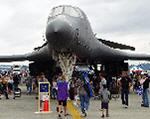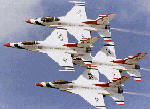
|
Description
| Manufacturer: | Temco | |
| Base model: | T-35 | |
| Designation: | YT-35 | |
| Nickname: | Buckaroo | |
| Designation System: | U.S. Air Force | |
| Designation Period: | 1948-Present | |
| Basic role: | Trainer | |
| Status: | Prototype | |
Specifications
| Not Yet Available |
Known serial numbers
Recent comments by our visitors
| Alastair Robertson Ramsgate, KY | I read somewhere that up to four of the Saudi Buckaroos ahd been brought back to the USA and restored to flying condition. Does anyone know if this is true? If so where are they?
I'm interested in the early history of the Royal Saudi Air Force(1945-1960)hence my interest. Alastair 12/04/2006 @ 14:30 [ref: 14908] |
| Geoff Jones GUERNSEY, CHANNEL ISLANDS, AL | I saw one of the few remaining and potentially airworthy Buckaroo\'s last July at Porterville in California. N1135T has been owned by Bill Vandersande for many years - along with his Mooney Mite - but it\'s now not been flown for some years because he has a medical condition. I think he\'d sell it if someone made him a sensible offer.
Glad of any comments about what the Buckaroo is like to fly and other survivors. Regards, geoff Jones 03/28/2006 @ 05:04 [ref: 12949] |
| Neil Weaver Carson City, NV | Just saw the T-35 on display in Riyahd, Saudi Arabia. April 2005. Beautiful museum. Have photos if you want. 12/28/2005 @ 13:08 [ref: 12033] |
| Joe Connell Stewartville, MN | (From: www.vought.com/y50-61/html/temco.html)
The Temco TE-1A, TE-1B/T35 Buckaroo. Early in 1948 Temco’s President Robert McCulloch received an inquiry from the Philippine government expressing an interest in a tandem trainer version of the Swift airplane. The first TE-1A was a modification of the Swift GC-1B, hand-built to rough layout drawings, the major difference in appearance being the tandem seating arrangement which resulted in a narrow windshield and an elongated two-piece canopy with a fixed bubble at the rear. This TE-1A prototype was completed late in 1948. After initial flight tests a 145-hp Continental engine replaced the original 125-hp installation. Early in 1949 Temco’s management received word that the Air Force planned to hold a competition early in 1949 for a new primary/basic trainer. Temco built two additional prototypes for this competition, adding some minor improvements as time permitted. Temco was competing with two other training airplanes, namely the Fairchild XNQ-1 and Beech Aircraft’s Model 45. On February 24, 1949, the Air Force trainer evaluation board chose the Beech Model 45 by a four to one vote. Temco’s TE-1A was a distant third. Although the USAF had decided against the TE-1A, interest had increased on the part of foreign governments, particularly the Philippine Republic. After a study of the competition evaluation, Temco decided to proceed with a program to improve the TE-1A. Some of the redesign included: a. A three-inch increase in the overall length of fuselage and a change in its cross section to be more compatible with the tandem seating. b. The horizontal tail was raised nine inches. c. Wing and fuselage fillets were added. d. Improved landing gear with main gear relocation to improve ground handling characteristics. e. Structural improvement in the wing to meet 9g loading. Equipment and equipment installation changes were made including a change from a 12-volt to a 24-volt electrical system and radio installation changes to meet Air Force standards. Concurrent with all this redesign Temco had decided to build, on speculation, ten of these production models powered by 145-hp engines. Late in 1949 with the engineering and tooling about 75% complete, Temco received an order for three of the redesigned TE-1A’s that would be designated AF T-35. The Air Force trainer competition had been revived. An evaluation program using students flying competing aircraft would be held at Randolph Air Force Base. Following receipt of the Air Force order, Temco decided that in addition to the extensive changes that had been made to the TE-1A, a 165-hp Franklin engine would be installed. The Air Force agreed to the change, and this model was designated the TE-1B and given the name “Buckaroo”. Development of the TE-1A and the TE-1B continued concurrently. The TE-1A was designated for export, and the TE-1B was for the Air Force. One TE-1A was bought by the Israeli Air Force and a second one was bought by the Greek Air Force. In July, 1950, the three YT-35 Buckaroos were delivered to Randolph AFB to compete with the Beech T-34 Mentor, the Fairchild T-31, Boulton Paul Balliol, and the DeHavilland DHC-1B Chipmunk trainers. Later in 1950 the Korean War disrupted many U.S. military programs including the YT-35 evaluation. The aircraft ended up at Connolly AFB, San Marcos, Texas. After ten months of rigorous training, the three YT-35’s were returned to Temco in late July, 1951, for factory overhaul. They then were assigned to Goodfellow AFB where later all three were sold as surplus. The majority of the TE-1B’s were sold to Saudi Arabia through the USAF under the mutual defense aid plan. Temco’s contract with the Saudis called for ten TE-1B/T-35 aircraft and enough spares to keep them flying for years. The Saudi Arabian TE-1B aircraft included two 30-caliber machine guns, one mounted inside each wing and ten 2.75-inch rockets, five mounted under each wing. 08/07/2002 @ 14:45 [ref: 5441] |
Recent photos uploaded by our visitors





